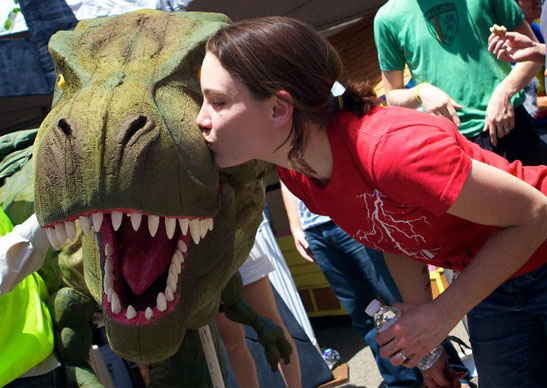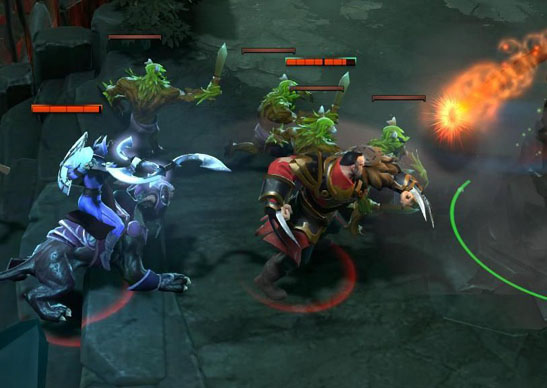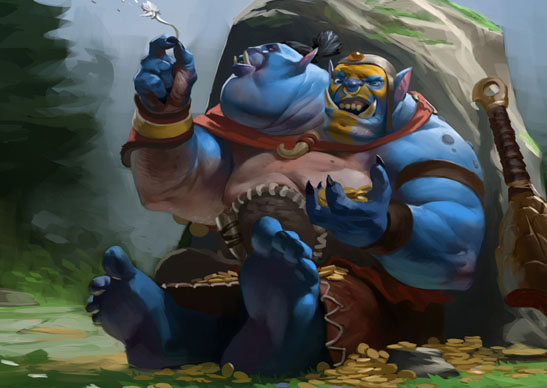Valve are responsible for some of the biggest games on the planet including the Half-Life series, Left 4 Dead, Team Fortress, Portal and Counter-Strike. For the past few years Christine has been working on Dota 2, a new online battle game that has grown from a community mod for Warcraft III.

Before Valve, Christine worked for Double Fine Productions and LucasArts Entertainment, as well as spots of freelance work for animated TV commercials and iPad apps. In the build-up to BAF Game 2012, we caught up with Christine over email to shed a little light on her perspective of the games industry.
Hi Christine! Did you always dream of working in the games industry?
I hate to be another one of those people telling the ‘ever since I was a little kid I’ve loved this’ story, but it’s totally true (after dinosaurs and deep sea fish…)
There was something fascinating about creating a world that you could spend as much time as you wanted exploring, a place to talk with your audience; and, as an animator, helping to build an entire living world was a huge attractant over linear media for me.
Film can be somewhat limiting—it only allows you to tell a story to a passive viewer, and as an animator you’re touching just a brief fragment of that story. In games, you’re an integral part of building an all-encompassing experience for someone. You are immersing your audience in something that will be taken in differently from person to person, and that’s awesome.
Is it easy to move between different industries? Are different skills needed to produce animation for a game compared to those needed for a television commercial?
Commercial work and games can be very different from one another, and switching mental gears (as it applies to animation style, available tools, schedule, etc) is probably the most challenging part for me.
With my freelance commercial work, time management has always been the biggest of my concerns. I’ve only ever worked off-location (usually for places in very different time zones), and those projects have always been opportunistic after-hours gigs for me, so communication and timely turnaround of work has been critical. Typically I’ve been given clear instructions on what is expected of my work in a shot and how long I have to do it in, so the work has been pretty straightforward for the most part.
With games I have needed to think about things on a broader scale—how does what I am working on fit into the greater whole of the project? What do the decisions I am making with this animation tell the player? Is this readable from all directions? Is the animation appropriately responsive to player input? Is this any fun for the player?
Games have also, out of necessity, been a bit more of a quantity over quality situation on most of my projects. I’ve needed to selectively pick my battles when it comes to polishing things and knowing what aspects of an animation (or of a whole character) needs more attention than others.

Do you get involved with the programming much? What’s it like working alongside a team of coders? Is there a lot of overlap?
Programming is something I have always been interested in—as much for self-sufficiency as an artist as being able to communicate with the people I work with day to day.
An animator and a gameplay programmer are the dynamic duo that make things come to life in a game, whether it’s an ambient critter in the background or a boss fight, so there is an immense amount of overlap with what our disciplines do. I have had the most fun as a game developer when I’ve worked with a gameplay programmer who is on the same page as I am, and we’ve rapidly prototyped and iterated on concepts together as a team.
What’s it like working at Valve? Is it very different to other game studios?
Valve is a very unique studio, though every place I have had the opportunity to work for has been completely different from the one before it.
At Valve I am my own boss—we don’t have a traditional hierarchy with leads and official titles, but rather just fill roles as needed. I can spend one day being an animator, and then another being a rigger, modeler, or designer. I decide day-to-day what the most productive use of my time would be, and apply my efforts to accomplishing that thing. Structure does happen, but it evolves organically from project to project rather than being imposed by ‘the powers that be’. This tends to result in a migratory lifestyle—with multiple projects happening all at once there is always a need somewhere. I have lost count of how many times I have wheeled my desk across the office since I started.
It’s exciting to work for Valve. A lot of the folks at the company are responsible for shaping the animated world I grew up in. I am in a constant state of learning there, and that knowledge extends well beyond animation. It’s hard not to absorb things from the talent at the studio.
What does a regular working day consist of?
Every day is different. Some days I am working on setting up a character rig to animate with. Some days I am working on the animation set of a new hero in Dota 2. Some days I am doing cinematic work, or sneaking off to help another project briefly. Some days I am working with other artists, programmers, and designers to create new player experiences, or to improve existing ones.
And some days I’m eating waffles and play testing Dota 2 for 8 hours straight—those are the hardest days of my life.

What advice would you give to an aspiring professional animator looking to find work for the first time?
It is important to ask yourself what you want to do, just as much as where you want to do it. Know who you’re applying to and the kind of work they do—that sort of research is super important.
For students: the school you go to does not matter. There are benefits and drawbacks to every program you could attend, but the most important thing you can do is to take responsibility for your own education. You need to actively seek out the information and skills you need for the industry rather than expecting them to be given to you.
The games industry is pretty competitive and getting that first gig can be tough, but if you do your research and pay attention you’ll do fine.
Do you think the games industry is too male dominated?
Haha, that’s a bit of a loaded question! There are certainly a lot more men than women in the games industry. At Valve, I am one of the two women on Dota 2 (the other being the super-rad Realm Lovejoy), which is a team that is approximately 70 or so developers—that makes roughly 3% of the Dota team female. This statistic has been fairly consistent at every studio I have worked for.
Of course I wish there were more women in the industry, but more than that I want the games industry to be a field that women are interested in contributing to. I find the work to be incredibly engaging, challenging, and rewarding. Diversity beyond gender in a development setting is invaluable—the more perspectives you have, the more varied your ideas, projects, and solutions to challenges will be.
Do you play many games in your spare time? If so, could you name your all-time favourites?
As a developer it is incredibly important to play games, to know what is happening in your industry, and to have as vast a library of knowledge to draw from as possible.
Journey is far and away the most impactful game I have played in a long time. Shadow of the Colossus, Super Smash Bros. Melee, Minecraft, Team Fortress 2, and Final Fantasy IX are the games I repeatedly return to on a regular basis.
Faster Than Light has been ravenously consuming all of my free time lately—it’s the closest I’ll ever get to being Captain Jean-Luc Picard of the Starship Enterprise.
Do you have a favourite film? Do films inspire your work?
Jurassic Park, hands down. I could eat that movie it’s so good.
All sorts of media inspire my work, but there are certainly a number of films (animated and otherwise) that have pressed the big red inspiration button for me. A lot of the short films that come out of CalArts and Gobelins really get me excited. The Team Fortress shorts were really influential for me, though I suppose that’s kind of a biased love for me now, isn’t it?
What other artists, animators, directors, games designers or writers inspire you?
Austin Wintory’s score for Journey was beautiful and moving. Music is pretty huge for me when I’m animating, both to set a tone for the work I am doing (I have a very extensive ‘Boss Battle’ playlist…), as well as a way of marking the tempo for a particular animation (especially physical action or cycle stuff). Music is really integral to any artistic work I do.
Pascal Campion is a ridiculously prolific and talented illustrator, and has a wonderful sense of posing, colour, and rhythm. He really knows how to distil a single drawing into what a moment of life is all about, in all its subtlety.
I can’t even begin to list the various comic artists—both traditional print and online—that have been influential for me. The overwhelming diversity of concepts, visual styles, and how the stories are executed is incredibly inspiring.
Thanks Christine!